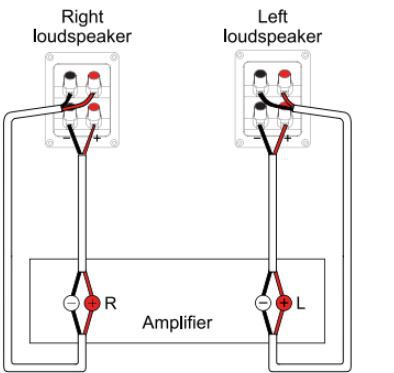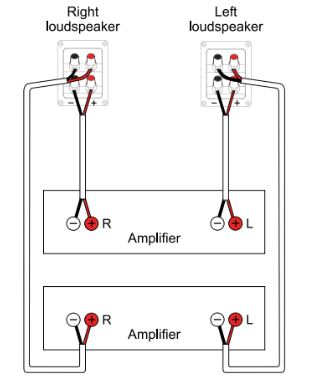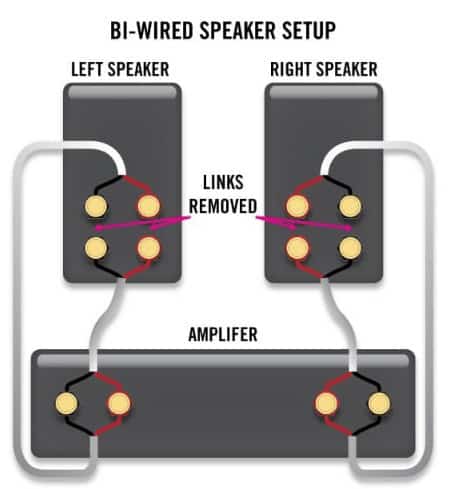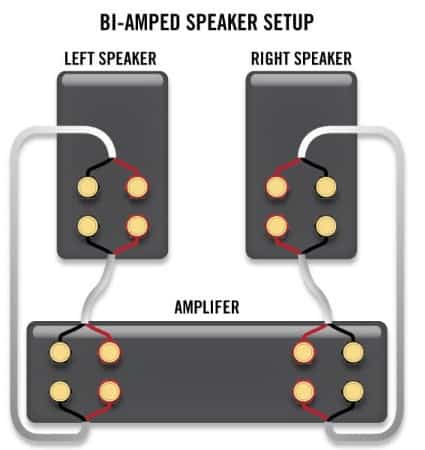Bi-Wiring and Bi-Amping are two audio enhancing techniques that are mainly utilized by professional sound engineers and audiophiles.
If these terms seem alien to you, then buckle up – we're about to completely unravel the mystery.
For years, people have been working towards developing better and more advanced sounds. This has led to the discovery of such fantastic inventions such as the gramophones, microphone, and speakers.
Rather than driving sound like a single signal, we're now able to separate it into several frequency ranges. These are categorized as either high, low or mid-range. Each frequency is then driven into its respective output device.
Let's discuss Bi-Wiring and Bi-Amping:
What is Bi-Wiring?
The term "Bi-wiring" is often used in the context of hi-fi systems. It refers to the process by which a loudspeaker is securely connected to a suitable audio amplifier.
The process of wiring stereo speakers has been around for several decades now – the first bi-wired loudspeaker was constructed during the late 1980s.
A bi-wired speaker usually has four connection terminals instead of two, so it's easy to distinguish them from the conventional speakers.
Normally, a single cable connects the amplifier to the loudspeaker. At the terminals, several audio crossover networks are used to connect the audio system to the loudspeaker drivers.

But for bi-wiring, two cables and two connector pairs are used to connect each loudspeaker to the amplifier output.
One cable feeds the tweeter (high frequency) driver while the other powers a different, low-frequency driver.
You might be wondering: what's the purpose of using two separate cable connectors?
Bi-wiring proponents claim that splitting the wires lowers traces of magnetic interaction within the cable, helping to improve the audio quality.
There's always a general consensus among bi-wiring enthusiasts: bi-wiring stereo speakers improve the sound of stereo systems, resulting in a significant audible enhancement that tramples single-cabled speakers.
However, some critics dismiss bi-wiring as a mere manufacturers' gimmick aimed at squeezing a few extra bucks from the pockets of their customers.
These claims are backed by the lack of sufficient evidence to support the process of bi-wiring – technical analysis of bi-wired networks shows that the general improvement of this arrangement is small and bears slight significance compared to single-wired networks.
How to bi-wire speakers?
The process of bi-wiring your speakers isn't complicated. Most loudspeakers come with extra terminals that support bi-wiring. If you decide to take this route, be prepared to purchase twice as many cables as you would for conventional wiring.
Since bi-wiring is relatively expensive, some people use the term "buy-wiring" referring to the unnecessary costs they often have to incur when bi-wiring.
- The first process of bi-wiring involves removing the small shorting wires that usually connect the extra loudspeaker terminals.
- Next, get your two sets of cables and connect them to your amplifier terminals.
Run both cable sets to each of your speakers. As discussed earlier, each pair of cables serves a unique purpose: one pair powers the tweeters while another conducts low frequencies to the woofer components. Essentially, bi-wiring allows two different currents to run on two separate cables.
What is Bi-Amplification?
Here's another term you're likely to hear in the fascinating world of audio electronics: bi-amplification. As the name suggests, bi-amping is the process by which two or more amplifiers are used to boost different signals.
The amplified signals are later channeled towards the output devices, powering the tweeters, woofers, and subwoofers. Bi-amplification usually makes use of an active audio crossover that splits a single signal into separate frequencies.
An audio crossover basically consists of a filter that is commonly used by audiophiles to separate one audio signal into a couple of frequency ranges.

This filter prevents different drivers from receiving signals that aren't within their frequency ranges, protecting them from damage.
Frequencies first ought to be split separately before they're passed through an amplifier. An active crossover then determines the boosted frequencies and subsequently channels each signal to its respective drive units.
Bi-amping speakers and their benefits
Bi-amping speakers have a wide range of benefits. However, let's first discuss the two varying flavors of bi-amplification:
#1. Horizontal bi-amping vs Vertical bi-amping
The bi-amplification process is meant to boost the sound performance of any stereo system.
Vertical bi-amping utilizes two distinct amplifiers to split an audio signal into several frequencies. Each channel is then directed towards the speaker.
The benefit of using separate amps is that you're able to utilize a powerful amplifier to drive the strong, power-intensive woofers while a modest amp powers the less demanding tweeters.
Horizontal Bi-amping, on the other hand, doesn't require an extra amp to configure – you can simply utilize the back channels of your stereo to bi-amp.
This type of bi-amplification is more popular among audiophile enthusiasts because it's inexpensive and easier to set up.
However, it's important to activate your preamp or receiver by assigning the surround back channels to bi-amp. This will allow the speakers to receive the second front channel signal.
#2. Active Bi-Amping vs passive Bi-Amping
Another unique bi-amplification category that you ought to understand is active and passive bi-amplification.
Passive bi-amping is quite common and simply involves directing two separate channels coming from the amplifier to every distinct speaker. An Onkyo bi-amp can help you achieve this type of configuration.
However, bi-amping fanatics agree that active bi-amplification of your speakers is the better, more effective criteria.
The process of active bi-amplification involves engaging the audio crossovers and splitting an individual sound signal into several frequencies (High, Mid and Low frequencies) before it reaches the amplifier and finally sending to the output devices. These devices include the speakers and tweeters.
This bi-amping process bypasses the stereo's internal crossover system, offering the active crossovers full control.
Bi-amp vs Bi-wire
The difference between bi-wiring and bi-amplification is as clear as daylight.
Bi-wiring basically involves running two separate cable pairs from the amplifier to the loudspeaker whereas bi-amping entails using two separate amplifiers instead of one to power the tweeters and speaker units.
Both processes have their unique benefits and demerits that are easy to spot. However, the question still remains: which arrangement provides better results?
For decades, there has been worldwide speculation trying to ascertain whether bi-wiring really provides significant audio improvement. Critics view it as a shameful gimmick aimed at encouraging loyal customers to part with more money.
A normal connection would necessitate a single pair of connecting cables running from the power amplifier to the output elements (speakers and tweeters). However, bi-wired systems involve running an extra pair of connecting cables from the amp to each separate drive unit.
This means you'll spend more money to purchase the extra connectors. However, several circuit analysis tests have unearthed that bi-wired systems provide a negligible boost in performance compared to single wired configurations.
Bi-amping seems to provide better audio performance when compared to bi-wiring. The process of bi-amplification transmits the audio input signal into an active crossover that splits the signal into separate frequency components that are later passed through two individual amplifiers.
This connection improves the overall efficiency of your audio system. It's a load-sharing type of configuration which guarantees negligible wastage of energy as heat. Another benefit of active bi-amping is lowered levels of intermodulation distortion.
Since the load is split and shared by two amplifiers, chances of tweeter distortion are reduced considerably. Power is also allocated more efficiently in this system, allowing users to utilize a feeble amp for the tweeters and a powerful amp for each of the power-sucking woofers.
Home Amping
Most people regard amping speakers to be a reserve of audio professionals. However, it's possible to amp your home system without requiring much help.
- The first step should involve creating a succinct list of all components you'll require (this includes power amps, connectors, speakers and tweeters).
- Next, create a budget highlighting how much money you'll need, then head out to purchase this equipment.
Before bi-amping your speakers, first, figure out which configuration you'd like to use: whether active or passive class 2 wiring speakers.
Passively bi-amping your speakers is less tedious than most people envision. Simply utilize an Onkyo bi-amp – this unit helps to enhance the treble and bass quality of your music.
However, first confirm whether your speakers support bi-amping before setting the ball rolling. If you're not much into DIY, request for help from a qualified individual who knows his way around the ropes.
Frequently answered questions:
How to bi-amp speakers with two amps?
Run one pair of cables from the more powerful amp to each of the speakers (right and left speaker). Next, run a second pair of connectors from the less powerful amp to your tweeters.
How to bi-wire speakers to a receiver?
Connect wires at the speaker terminals and run them to the amplifier. Get a second pair of wires and connect them from your tweeter terminals to the amplifier receiver. This creates a bi-wired system.
How to wire speakers with 4 terminals?
Speaker terminals are differentiated using two distinct colors: red and black. If you're single wiring, simply connect one end of the black cable onto the black-colored terminal and the other end onto the amplifier's black terminal. Next, connect the red connector to the speaker's red terminal and the other end onto the amplifier's red terminal. The two extra terminals are used for bi-wiring purposes.
How to bi-amp speakers with one amp?
It's possible to bi-amp speakers using a single amp if you're using the horizontal bi-amping configuration discussed within this article.
How to hook up speakers to the amp?
You can use cable connectors to link your amplifier to your speaker elements. Both the amp and the speakers contain a pair of connector terminals at the back – each terminal is colored red and black. Simply connect the black cable onto the black terminals and the red cable onto the red terminals.
How to bi-amp front speakers?
You can bi-amp the front speakers by utilizing channels 6 and 7 on your Onkyo bi-amp.
Conclusion
Bi-wiring and bi-amping your speakers help to produce better, more pronounced sound from your stereo system. Both processes have wide-ranging configurations and benefits.
For instance, some sound engineers believe that bi-wiring helps to reduce the magnetic interference experienced when audio frequencies are bundled in one pair of connectors.
However, not everyone holds these sentiments – some view this process as a deliberate scheme to help buyers reach deeper into their pockets, terming it "buy-wiring".
Bi-amping has widely accepted perks that generally help to boost audio performance. For instance, it limits audio distortion in the tweeters and distributes the load evenly to avoid overburdening the speakers.
It's also easier to control the power level when utilizing active bi-amping techniques. All those passionate audiophiles looking to improve their stereo performance ought to try these two techniques.



